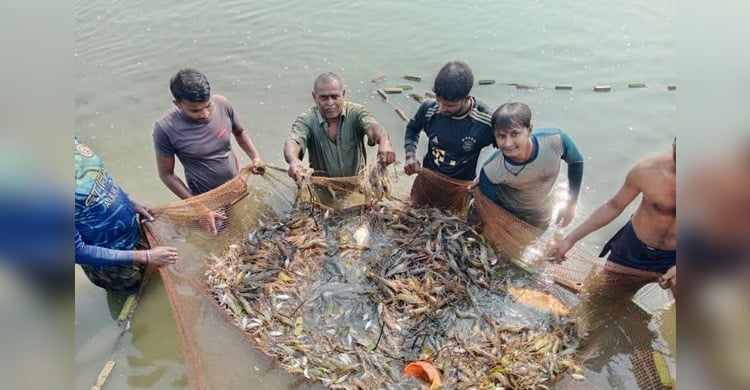Cluster method becomes boon for many shrimp farmers in Khulna


Cluster method shrimp farming has become a boon for many of the shrimp farmers as it gives almost double yield in the region during the last couple of years.
Previously, conventional shrimp farming had been resulting in losses for farmers for several years. Farmers had suffered a lot due to various problems including shrimps' deaths, water salinity, climate change and diseases.
Apart from this, climate change and diseases have devastated shrimp farmers causing them to face losses they have never encountered before. A constant loss of income led to a financial disaster for farmers in the Khulna region.
Currently, the new cluster method developed and promoted by the Department of Fisheries (DoF) has generated paths for the farmers towards looking forward for making them free from the disaster.
The 'Sustainable Coastal and Marine Fisheries' project is being implemented in 29 upazilas of Khulna, Bagerhat, Satkhira, Jessore and Gopalganj districts.
Talking to BSS here, Deputy Project Director Saroj Kumar Mistry said coastal and marine fisheries farmers have been well organized and 297 clusters have been included in the project.
There are 25 enclosures in each cluster. Each enclosure is between 33 and 150 decimals in size. These clusters cover a total of 5,405 acres of land.
Through the project, 7,378 shrimp farmers, including 1,622 females, have been organized into the clusters.
Under the project, farmers were imparted improved technical training apart from promoting improved farming methods instead of the conventional one.
In addition to intensifying bio-security measures, disinfectant and healthy post-larvae and qualitative supplementary foods were used.
Cluster-based shrimp farming has brought new hopes to the farmers as it increases production and lessens shrimp mortality.
Terming the cluster cultivation as a collection of interrelated farms he said a cluster is an organisation consisting of farmers of a particular area and members work in a coordinatedand institutionalised manner to achieve specific goals and objectives.
"Cluster shrimp farming has opened up new possibilities for increasing safe shrimp production, developing coastal agro-economy, poverty alleviation and achieving SDGs," he added.
He further said this is an effective way to increase shrimp production in coastal areas. The farmers in the southern sub-coast are well organised and expanded shrimp farming in a cluster system.
A new door has also been opened for massive employment through increasing the production of shrimp.
A part from this, shrimp farming in cluster systems has neen playing an important role in dealing with climate-related risks.
Saroj Kumar Mistry said they are training the farmers on modern shrimp farming methods. Emphasis has been given to increasing enclosure depth, ensuring bio-security, wideningand raising roads, PCR lab-tested virus-free PCF fry stock and good aquaculture practices.
Tapan Kumar Karmoker, Upazila Fisheries Officer in Koyra, said ten clusters have been formed. Farmers in the cluster are responsible for digging on their own to increase the depth of the enclosures.
On behalf of the project, each of the enlisted farmers was given financial support for digging and road construction; shrimp fry collection, enclosure preparation, good aquaculture practices, electricity, construction of office rooms and purchasing necessary equipment.
"We have been successfully cultivating shrimp in clusters. DoF advice are benefitting farmers enormously," said Sheikh Mahtab Hossain, president of Tipna New Road Prawn Cultivation Cluster in Dumuria upazila of Khulna.
He said the cluster system of shrimp farming benefits coastal farmers. Since adopting the system, shrimp production has increased significantly.
In the eyes of some people involved in shrimp farming, the model has given the industry a new lease on life.
Suvendra Biswas, President of Boro Danga Prawn Farmers Cluster-1 of Dumuria Upazila of Khulna, said they have been farming shrimp in the cluster system for the last couple of years successfully.
"The fisheries officers trained us. As per their instructions, I have succeeded in cultivating shrimps in the cluster system. The production has increased more than twice as before," he said.
He further added, "I was given a matching grant by preparing 25 enclosures as per the advice of the DoF. We are happy after adopting the cluster system."
Jahangir Alam, Divisional Deputy Director of DoF, said the cluster system is the modern version of shrimp farming. In this method, the depth of the pond has to be 4-5 feet. Funding is provided to only the clusters that meet the necessary conditions.
During the baseline survey in 2018, production of golda shrimp was seen 623 kilograms per hectare, while bagda was 323 kilograms.
Quoting the data received from the farmers using cluster system in the 2022-23 financial year, he said production of galda as seen stood at 1,190 kilograms per hectare and 813 kilograms of bagda.
